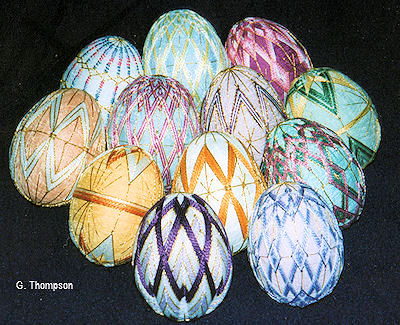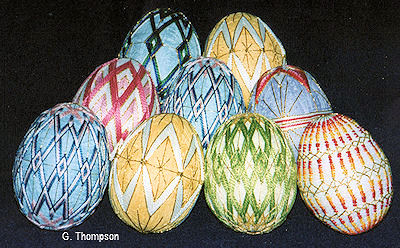Temari Designs on Eggs
Temari are, by definition, balls. So, technically, there isn't something called a Temari Egg. However, many temari designs can be adapted and applied to egg forms, and are somewhat popular (you will find a few tucked into a couple of Japanese books). This is one time when
 using a
pre-formed egg shape as the base is recommended, since making a uniform
egg from scratch is a challenge. There are many varieties to be found on
the craft market year-round, given the popularity of decorative egg
making and collecting. Plastic, wood or Styrofoam are recommended, as
natural blown-out shells are too fragile. There is a wide range of
shapes and sizes depending on the bird the egg is modeled after.
using a
pre-formed egg shape as the base is recommended, since making a uniform
egg from scratch is a challenge. There are many varieties to be found on
the craft market year-round, given the popularity of decorative egg
making and collecting. Plastic, wood or Styrofoam are recommended, as
natural blown-out shells are too fragile. There is a wide range of
shapes and sizes depending on the bird the egg is modeled after.It is easiest to stick to patterns that are polar in orientation when you are starting out stitching eggs, but then it is certainly possible to modify further divisions onto the egg shape. You will have to adapt, and it helps to have a solid working knowledge of combination markings on balls before you begin trying to adapt them to eggs, but it can be done. And of course, you can also use free embroidery with or without using geometric divisions.
Wrapping the bases gets to be a tad interesting since you do not have a symmetrical shape over which to distribute the wraps; with a little practice you'll be doing them as easily as you do regular round mari. A TalkTemari group member offered up a great hint a while back - for the first layer in the wrapping, use a covering of gauze bandage. Be sure to use plain gauze bandage, not "Kling" or other adhesive bandage. It works great, as it has a bit of give and stretch so it form-fits somewhat, and it also gives more friction for the thread wrap to "stick" to, as well as adhering to itself a bit. Don't worry about a few small lumps or bumps, they can be smoothed out in the wrapping to come. The thinner the strip of gauze, the easier it is to wrap and smooth, but wider bandage is less expensive and a much better bang for the buck. Buy a 2 or 3 inch (or even 4) wide roll, and cut the entire roll into thinner sections with a good pair of shears. The gauze is wonderfully stretchy and molds to the egg shape with little effort. Use a covering of several layers deep of the gauze; if you are using a plastic or other very smooth egg base to begin with, use a small strip of double stick tape to get things going with the gauze. Once you have one wrap going, you're fine but a very slippery base can be challenging to get started.
 Add a good layer of fine
yarn as the next wrapping layer. It should be something like "fine" or
"very fine" in the revamped current yarn standard. Just as
wrapping round mari, keep the egg moving as you wrap, covering all areas
including the "shoulders" between the ends and middle. Don't use a too
tight a tension or the wrapping will slip and pop off. Take advantage of
the friction from the gauze and be sure that you are covering the egg
evenly. After the yarn then of course comes the thread - again, try to
work evenly, and not too tightly. If needed, stop and cut the thread and
take some long zig zag stitches around the egg to anchor things in place
and then begin wrapping again. You want as nice a stitching surface for
the egg as you do a ball, so don't skimp even if you are tempted.
Add a good layer of fine
yarn as the next wrapping layer. It should be something like "fine" or
"very fine" in the revamped current yarn standard. Just as
wrapping round mari, keep the egg moving as you wrap, covering all areas
including the "shoulders" between the ends and middle. Don't use a too
tight a tension or the wrapping will slip and pop off. Take advantage of
the friction from the gauze and be sure that you are covering the egg
evenly. After the yarn then of course comes the thread - again, try to
work evenly, and not too tightly. If needed, stop and cut the thread and
take some long zig zag stitches around the egg to anchor things in place
and then begin wrapping again. You want as nice a stitching surface for
the egg as you do a ball, so don't skimp even if you are tempted.Marking is very similar to a ball. You will have to eyeball the centers of the ends - and sometimes it does need some trial and error to find it. Use a paper strip or tape measure as needed. If you are using a hard egg base, you'll not be able to sink pins into it, which means working carefully. Using something like shorter dress-maker pins, or even sequin pins may be helpful. I do most of my dividing by eye and then check things with a tape measure on eggs.... the oval shape can be a tad different to "see". The usual needs and hints of dividing and marking a ball apply to eggs, with of course some common sense adaptations as needed. See the pages on dividing and marking mari in the How To section for the basics if needed. Many traditional stitches and designs can be worked or adapted to egg shapes - use your imagination and perhaps a bit of trial and error, and have some fun with them.
This
is a TemariKai.com Printable Page; © 2014, all rights reserved.
Right click to print one copy for personal use.
Last updated 1/2014 © 1998 - 2014 TemariKai.com, G. Thompson/PuffinStuff, Inc.
